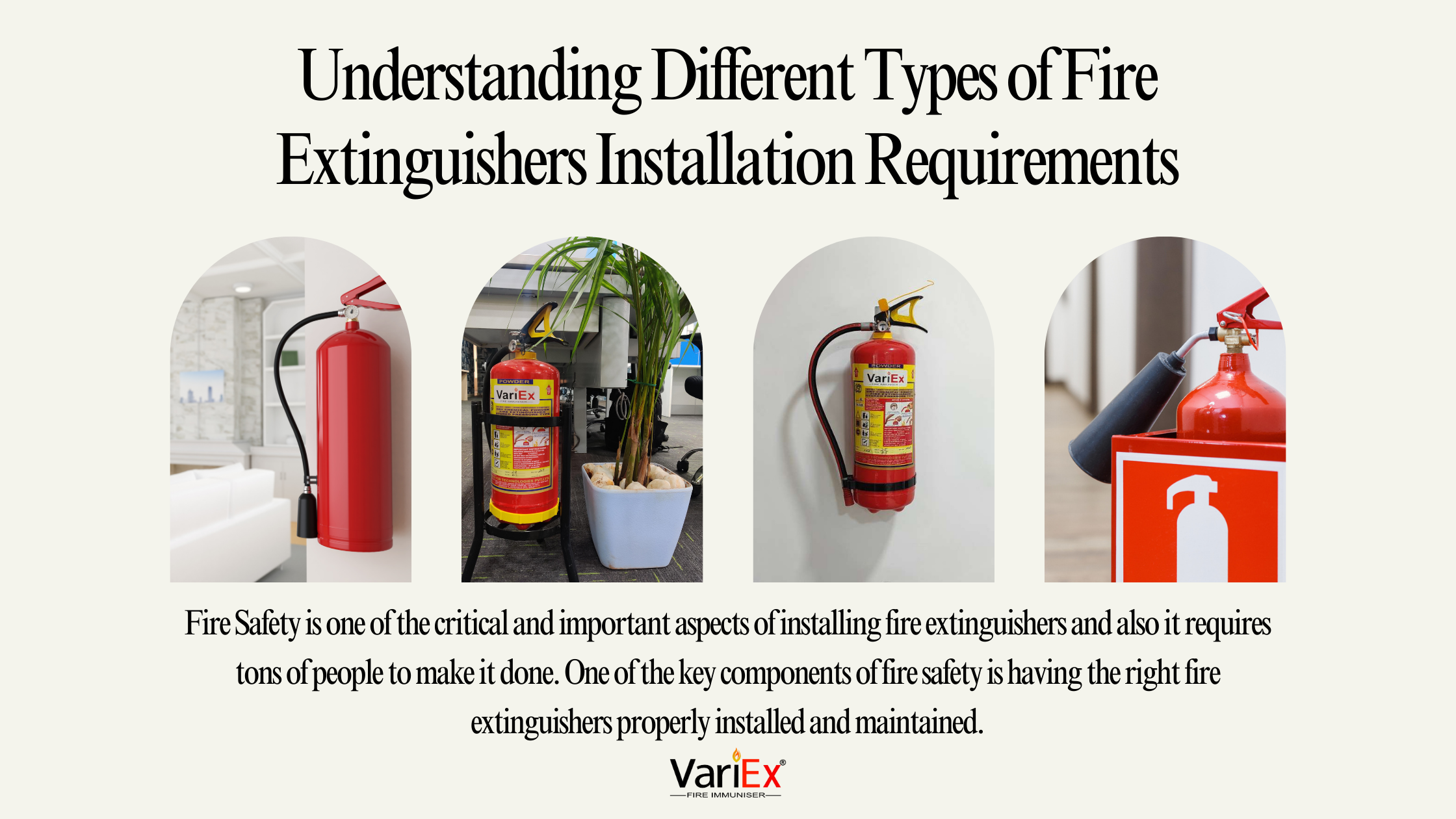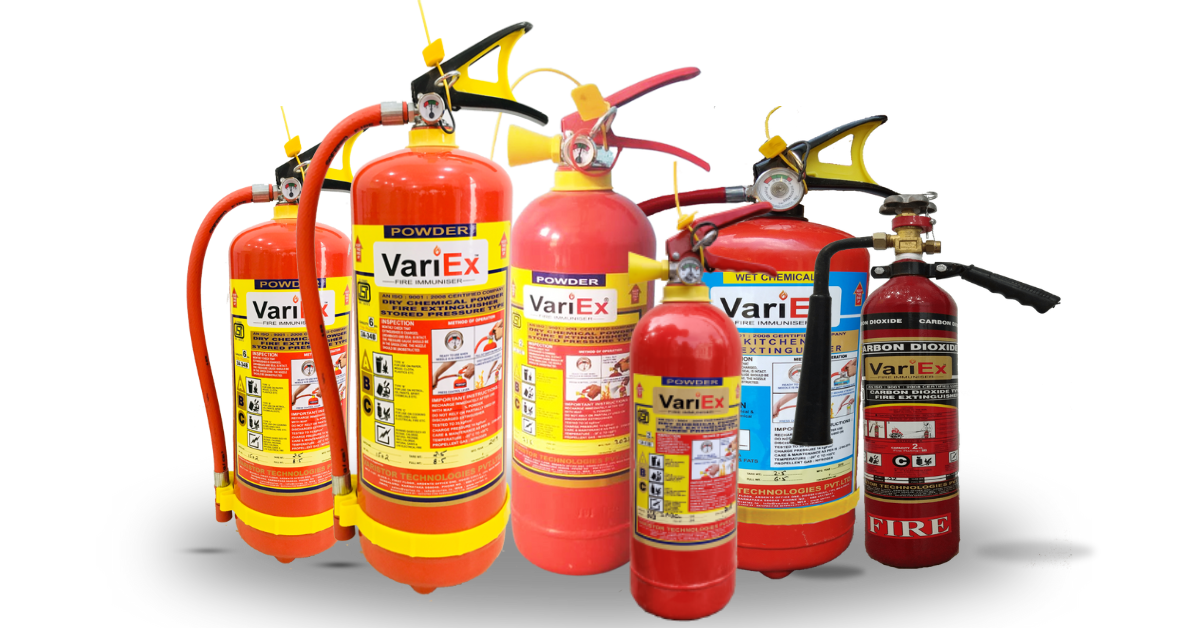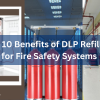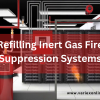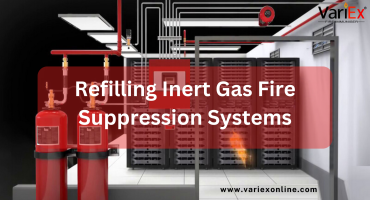![]()
Fire Immuniser
+91-7829629111
Email: info@variex.in
Varistor Technologies Pvt. Ltd.
Block-1, First Floor, Ardente Office One, Hoodi Circle, ITPL Main Road, Bengaluru, Karnataka 560048, IN
Understanding Different Types of Fire Extinguishers Installation Requirements
Fire Safety is one of the critical and important aspects of installing fire extinguishers and also it requires tons of people to make it done. One of the key components of fire safety is having the right fire extinguishers properly installed and maintained. To setup a fire installation and to keep it maintained it has to be done under proper guidance. Let's see what are the steps needed to setup the various types of fire extinguishers, their uses, and how it will be installed.
The Basics of Fire Extinguishers.
Fire extinguishers are the devices that is used for small fires or controlling them till you get the professional help. There are different classes of fire extinguishers and each of them are designed to combat the different classes of fires.
It is tested that fire extinguisher depends not only on its type but also on its placement and it's maintenance. Installing a fire extinguishers need a proper maintenance, and how we can tackle them based on the different classes of fire.
- Class A: Class A considered to those types of fire which is paper, wood, cloth and some plastics.
- Class B:Class B considered to those types of fire which is gas, oil, petroleum etc.
- C lass C: Class C considered to those types of fire which is of electrical equipment.
- Class D: Class D considered to those types of fire which include metals like titanium, sodium, magnesium etc.
- Class K: Class K considered to those types of fire which is oil, fats commonly found in kitchen.
Water Extinguishers
Water Fire Extinguishers Uses: Primarily for Class A fires involving combustible materials such as wood, paper, and cloth.
Installation Requirements | Advantages | Limitations |
|---|---|---|
- Areas with Class A fire hazards | - Cost-effective and widely available | - Not suitable for Class B, C, D, or K fires |
- Commonly found in schools, offices, and public buildings | - Simple to use with a cooling effect on the fire | - Using water on electrical fires (Class C) can cause electrical shock |
- Must be placed near exits or escape routes for easy access |
Foam Extinguishers
Foam Fire Extinguishers Uses: Effective on Class A and B fires, especially useful for flammable liquids.
Installation Requirements | Advantages | Limitations |
|---|---|---|
- Areas with mixed fire risks, such as workshops, garages, and commercial kitchens | - Forms a barrier over the flammable liquid, preventing re-ignition | - Not suitable for Class C (electrical) fires |
- Placed near potential fire hazards and along escape routes | - Can be used on some Class A fires | - More expensive than water extinguishers |
Carbon Dioxide (CO2) Extinguishers
Carbon Dioxide (CO2) Fire Extinguishers Uses: Ideal for Class B and C fires involving flammable liquids and electrical equipment.
Installation Requirements | Advantages | Limitations |
|---|---|---|
- Commonly installed in areas with a significant amount of electrical equipment, such as server rooms, laboratories, and offices | - Leaves no residue, making it safe for sensitive electrical equipment | - Not effective on Class A fires |
- Should be placed close to the fire hazards but not in confined spaces due to the risk of suffocation | - Effective at suffocating the fire by displacing oxygen | - Can cause cold burns if handled improperly |
Dry Chemical Extinguishers
Dry Chemical Extinguishers Uses: Versatile and effective on Class A, B, and C fires.
Installation Requirements | Advantages | Limitations |
|---|---|---|
- Suitable for a wide range of environments, including homes, offices, workshops, and industrial settings | - Multi-purpose use across different fire classes | - Can leave a residue that may damage sensitive equipment |
- Should be installed near potential fire hazards and along escape routes | - Effective at quickly knocking down flames | - Requires regular maintenance to ensure functionality |
Wet Chemical Extinguishers
Class-K Fire Extinguishers Uses: Designed specifically for Class K fires involving cooking oils and fats.
Installation Requirements | Advantages | Limitations |
|---|---|---|
- Must be installed in commercial kitchens, restaurants, and food preparation areas | - Effective at cooling and suppressing fires involving cooking oils | - Not suitable for other fire classes |
- Should be easily accessible and located near cooking appliances | - Reduces the risk of re-ignition | - Requires proper training to use effectively |
Dry Powder Extinguishers
Dry Powder Extinguishes Uses: Suitable for Class D fires involving combustible metals.
Installation Requirements | Advantages | Limitations |
|---|---|---|
- Installed in areas where combustible metals are used, such as laboratories, manufacturing plants, and workshops | - Specifically designed for metal fires | - Ineffective on other classes of fires |
- Should be placed near the specific metal hazards but not near areas with mixed fire risks | - Can be used on a wide range of combustible metals | - Requires specialized knowledge to use correctly |
Installation Best Practices
Proper installation of fire extinguishers is critical to ensure they are easily accessible and effective in an emergency. Here are some best practices for installation:
Assessing Fire Risks
- Conduct a Fire Risk Assessment: Identify potential fire hazards and determine the types of fires that may occur in your environment.
- Determine the Number of Extinguishers Needed: Based on the fire risk assessment, calculate the number of extinguishers required to cover all areas adequately.
Placement and Accessibility
- Mounting Height: Fire extinguishers should be mounted at a height that allows easy access, typically no more than 5 feet from the floor.
- Visibility: Ensure extinguishers are clearly visible and unobstructed. Use signs and labels to indicate their locations.
- Accessibility: Place extinguishers near exits and escape routes to facilitate easy access during an emergency. Ensure they are not blocked by furniture or equipment.
- Distribution: Distribute extinguishers evenly throughout the premises. In larger areas, ensure that no one has to travel more than 75 feet to reach an extinguisher.
Installation Requirements by Environment
- Residential: Place extinguishers in key areas such as the kitchen, garage, and near exits. Ensure they are easily accessible but out of reach of children.
- Commercial: Install extinguishers in accordance with local fire codes and regulations. Common areas include offices, hallways, kitchens, and electrical rooms.
- Industrial: Given the higher risk, install multiple extinguishers throughout the facility, particularly near high-risk areas such as chemical storage, machinery, and welding stations.
Maintenance and Inspection
Regular maintenance and inspection are essential to ensure fire extinguishers are in working condition:
- Monthly Inspections: Check that extinguishers are in their designated locations, accessible, and not damaged. Ensure the pressure gauge indicates the correct pressure.
- Annual Maintenance: Have a certified professional conduct a thorough inspection and maintenance check at least once a year.
- Hydrostatic Testing: Periodically test the extinguisher's cylinder for structural integrity, as recommended by the manufacturer.
Training and Awareness
- User Training: Ensure that all occupants are trained on how to use a fire extinguisher effectively. Conduct regular fire drills and training sessions.
- Awareness: Educate occupants on the types of fire extinguishers available and their specific uses. Ensure they understand the importance of not using the wrong type of extinguisher on a fire.
Conclusion
Understanding the different types of fire extinguishers and their installation requirements is vital for effective fire safety. By choosing the right extinguisher for each potential fire hazard and ensuring proper installation and maintenance, you can significantly enhance your ability to respond to fire emergencies. Whether in a residential, commercial, or industrial setting, being well-prepared with the correct fire extinguishers can save lives and protect property.
Remember, fire safety is a continuous process. Regularly review and update your fire safety measures to adapt to any changes in your environment. Stay informed, stay prepared, and stay safe.
FREQUENTLY ASKED QUESTIONS
Install fire extinguishers at accessible, visible locations near exits and fire hazards, ensuring no more than 75 feet of travel distance. Mount them securely at 3-5 feet from the floor. Comply with local fire codes, conduct regular maintenance, and provide occupant training on proper use.
Water extinguishers: install near Class A fire hazards; Foam extinguishers: near Class A and B hazards; CO2 extinguishers: by electrical equipment; Dry chemical extinguishers: cover multiple hazards, including A, B, and C fires; Wet chemical extinguishers: in commercial kitchens; Dry powder extinguishers: near combustible metals.
Avoid blocking access, installing at incorrect heights, or using the wrong extinguisher type for specific hazards. Ensure visibility, compliance with local codes, regular maintenance, and proper training. Do not place in hard-to-reach areas or neglect clear signage indicating extinguisher locations.
Local fire codes and regulations ensure fire extinguisher installation meets safety standards, specifying types, placement, accessibility, and maintenance. They mandate regular inspections, proper signage, and adherence to building-specific requirements, reducing fire risks and enhancing emergency preparedness. Compliance is essential for legal and insurance purposes.
Professional installation ensures compliance with fire codes, correct placement, and proper selection of extinguisher types. Experts provide reliable maintenance, reduce risk of installation errors, and offer training for effective use. This enhances safety, reliability, and legal compliance compared to DIY methods.
Final Say
At VariEx.in and VariexOnline.com, we specialize in supplying and installing top-quality fire fighting systems and equipment. From fire extinguishers to advanced suppression systems, we offer comprehensive solutions tailored to your needs. Our experienced team ensures precise installation and maintenance for optimal safety.
Trust VariEx for reliable fire protection. Contact us online or call 7829629111 to learn more.


